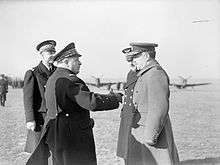Joseph Vuillemin

General Joseph Vuillemin (14 March 1883, Bordeaux – 23 July 1963, Lyon) was a French military aviator who took part in both world wars. He was Chief of Staff of the French Air Force during the first year of World War II.
First World War
In June 1915, he was promoted to captain and became a squadron commander in February 1918. During the war, he scored seven confirmed kills, thus earning the designation of French fighter ace of the First World War.
Inter-war years
After the war, he was given command of the ‘11e régiment d’aviation de bombardement en pays rhénan’ (11th Bomber Wing of the Rhine), and then put in charge of air operations in Algeria in 1925. He became a colonel in 1928 and assumed command of air operations in Morocco in 1932.
In February 1933, he was promoted to brigadier general (equivalent of air commodore in the RAF). Between November 1933 and January 1934, he led the so-called ‘La Croisière noire aérienne’ – an ambitious training and trailblazing mission from France via Morocco and the Sahara to French West Africa and French Equatorial Africa using French Potez 25 biplanes.[1][2][3]
Between 1935 and 1936, he commanded the ‘1er corps aérien’ (1st Air Corps) and, in July 1937, became a member of the ‘Conseil supérieur de l’air’ (Supreme Air Council) before being promoted to ‘général de division aérienne’ (equivalent of air vice-marshal in the RAF) in October of the same year.
At the same time as his appointment to Chief of Staff of the French air force on 18 February 1938, General Vuillemin became ‘vice-président du Conseil supérieur de l’air’ (Vice Chairman of the Supreme Air Council) and Inspector General of Home Air Defence. He was further promoted to the rank of ‘general d’armée aérienne’ (equivalent of air chief marshal in the RAF).
Second World War
At the outbreak of the Second World War, he became Chief of the Air Staff, a post he would hold until the Armistice with France (Second Compiègne) in June 1940. During the Battle of France, General Vuillemin repeatedly called for more British squadrons to come to the aid of French forces which were under severe attack from the German Luftwaffe. Commenting to General Edward Spears on 30 May 1940, the British Air Attaché in Paris, Air Commodore Douglas Colyer, criticised certain senior French officers saying that, while they had been very brave pilots in the last war, they were not sufficiently educated to command important formations now. In Colyer's view, included among these was General Vuillemin.[4]

On 12 June 1940, at a meeting of the Anglo French Supreme War Council at Briare, it was reported that a bombing raid by the RAF against Italy the previous day had been thwarted by General Vuillemin, who had ordered lorries to be driven onto the airfield as the bombers were preparing for take-off. He feared that such raids would provoke Italian reprisals, the consequences of which would be disastrous, as the French Air Force was not present in the south. Vuillemin requested that no raids be launched against targets in northern Italy unless these were carried out in response to attacks by the Italians. General Spears, who was present at the conference in his capacity of Winston Churchill's personal representative to the French Prime Minister, wondered why 'if he had bombers to bomb back in retaliation, why not use them now?' [5]
On 24 June 1940, Vuillemin was named Inspector General of the Air Force and given responsibility for the co-ordination of air defence operations. In November 1940, at his own request, he was removed from the active list of serving air force officers.
He died in Lyon on 23 July 1963, and was buried in the Cemetery de la Chartreuse at Bordeaux.
Ranks (approximate British equivalents)
- 8 March 1933 : Général de Brigade
- 1 April 1933 : Général de Brigade Aérienne (Air Commodore)
- 14 October 1936 : Général de Division Aérienne (Air Vice Marshal)
- 15 October 1936 : Rank and prerogatives of Regional Air Commander (Air Marshal)
- 24 June 1939 : Général d'Armée Aérienne (Air Chief Marshal) (retrospective effect from 1 July 1937)
- 24 June 1939 : Commander in Chief of the Air Force (retrospective effect from 22 February 1938)
Decorations
French decorations
- Chevalier - 8 September 1914
- Officier - 28 October 1916
- Commandeur - 1 May 1920
- Grand Officier - 2 July 1931
- Grand-Croix - 13 January 1934
- Médaille militaire - 17 July 1940
- Croix de guerre 1914–1918 (France)
- Croix de guerre des théâtres d'opérations extérieures avec 1 palme
- Médaille Interalliée de la Victoire
- Médaille commémorative de la guerre 1914–1918
- Médaille Coloniale with « Sahara » « Afrique " bars
Significant foreign decorations
- Morocco: Commandeur du Ouissam Alaouite Chérifien
- United Kingdom: Distinguished Service Order, Royal Victorian Order
- Tunisia: Grand Officier du Nicham iftikhar
The above is largely a translation of the article in the French Wikipedia fr:Joseph Vuillemin
References
- ↑ "La Croisière noire". Cocardes - Histoire de l'Aviation. Retrieved 2008-10-03.
- ↑ This airborne ‘Croisière noire of November 1933 – January 1934’ should not be confused with ‘La croisière noire of 1924-1925’, the latter a French land expedition across Africa using Citroen half-track vehicles.
- ↑ "Black Cruise". Citroën France. Retrieved 2008-10-05.
- ↑ Spears, Sir Edward (1954). Prelude to Dunkirk. London: Heinemann. pp. 332, p.287.
- ↑ Spears, Sir Edward (1954). The Fall of France. London: Heinemann. pp. 333, p.163, p.167.